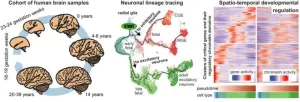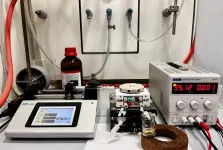(Press-News.org) BOSTON – The brain is made up of numerous types of cells that are organized into different structures and regions.
Although several important steps have been made towards building models of the human brain, the advances have not produced undistorted 3D images of cellular architecture that are needed to build accurate and detailed models.
In new research published in Science Advances, a team led by investigators at Massachusetts General Hospital (MGH), a founding member of Mass General Brigham (MGB), has overcome this challenge to offer scientists and clinicians a comprehensive cellular atlas of a part of the human brain known as Broca’s area, with detailed resolution to study brain function and health.
By combining different sophisticated imaging techniques—including magnetic resonance imaging, optical coherence tomography, and light-sheet fluorescence microscopy—the researchers were able to overcome the limitations associated with any single method to create a high-resolution cell census atlas of a specific region of the human cerebral cortex, or the outer layer of the brain’s surface.
The team created such an atlas for a human postmortem specimen and integrated it within a whole-brain reference atlas.
“We built the technology needed to integrate information across many orders of magnitude in spatial scale from images in which pixels are a few microns to those that image the entire brain,” says co–senior author Bruce Fischl, PhD, director of the Computational Core at the Athinoula A. Martinos Center for Biomedical Imaging at MGH and a professor in Radiology at Harvard Medical School.
Ultimately, the methods in this study could be used to reconstruct undistorted 3D cellular models of particular brain areas as well as of the whole human brain, enabling investigators to assess variability between individuals and within a single individual over time.
This will provide insights into the presence and spread of pathologic changes that occur in neurodegenerative and psychiatric illnesses.
“These advances will help us understand the mesoscopic structure of the human brain that we know little about. Structures that are too large and geometrically complicated to be analyzed by looking at 2D slices on the stage of a standard microscope, but too small to see routinely in living human brains, says Fischl.
“Currently we don’t have rigorous normative standards for brain structure at this spatial scale, making it difficult to quantify the effects of disorders that may impact it such as epilepsy, autism, and Alzheimer’s disease.”
Additional co-authors include Irene Costantini, Leah Morgan, Jiarui Yang, Yael Balbastre, Divya Varadarajan, Luca Pesce, Marina Scardigli, Giacomo Mazzamuto, Vladislav Gavryusev, Filippo Maria Castelli1, Matteo Roffilli, Ludovico Silvestri, Jessie Laffey, Sophia Raia, Merina Varghese, Bridget Wicinski, Shuaibin Chang, Anderson Chen I-Chun, Hui Wang, Devani Cordero, Matthew Vera, Jackson Nolan, Kimberly Nestor, Jocelyn Mora, Juan Eugenio Iglesias, Erendira Garcia Pallares, Kathryn Evancic, Jean Augustinack, Morgan Fogarty, Adrian V. Dalca, Matthew Frosch, Caroline Magnain, Robert Frost, Andre van der Kouwe, Shih-Chi Chen, David A. Boas, Francesco Saverio Pavone, and Patrick R. Hof.
Support for this research was provided in part by the BRAIN Initiative Cell Census Network, the National Institute for Biomedical Imaging and Bioengineering, the National Institute on Aging, the National Institute of Mental Health, the National Institute for Neurological Disorders and Stroke, Eunice Kennedy Shriver National Institute of Child Health and Human Development, Chan-Zuckerberg Initiative DAF an advised fund of Silicon Valley Community Foundation, Shared Instrumentation, NIH Blueprint for Neuroscience Research, European Union's Horizon 2020 research and innovation Framework Programme, European Union's Horizon 2020 Framework Programme for Research and Innovation, Marie Skłodowska-Curie, Italian Ministry for Education in the framework of Euro-Bioimaging Italian Node, European Research Council, Alzheimer’s Research UK, The National Institutes of Health, and "Fondazione CR Firenze" (private foundation) Human Brain Optical Mapping.
About the Massachusetts General Hospital
Massachusetts General Hospital, founded in 1811, is the original and largest teaching hospital of Harvard Medical School. The Mass General Research Institute conducts the largest hospital-based research program in the nation, with annual research operations of more than $1 billion and comprises more than 9,500 researchers working across more than 30 institutes, centers and departments. In July 2022, Mass General was named #8 in the U.S. News & World Report list of "America’s Best Hospitals." MGH is a founding member of the Mass General Brigham healthcare system.
END
Researchers develop technology to tabulate and characterize every cell in the human brain
The advance could establish the distributions of cells under healthy states and reveal how things go awry in neurologic diseases
2023-10-12
ELSE PRESS RELEASES FROM THIS DATE:
Americans will spend half their lives taking prescription drugs, study finds
2023-10-12
UNIVERSITY PARK, Pa. — An American born in 2019 will spend a larger share of their lifetime taking prescription drugs than being married or receiving an education, according to new research by Jessica Ho, associate professor of sociology and demography at Penn State. She found that American males will spend approximately 48% of their lives taking prescription drugs. The number jumped to 60% for females.
Ho reported her findings this week (Oct. 1) in the journal Demography.
“As an American, I’d like ...
Advertising rental housing in Spanish puts off many potential renters
2023-10-12
Publishing an ad for an apartment or rental home in Spanish may seem like it would broaden the pool of potential renters, but new research shows it can harm rental-seekers’ perception of the property and its neighborhood.
Finding a new apartment or home to rent can be nerve-wracking and tedious. It is increasingly digital and there are thousands of websites and Facebook groups for prospective renters to peruse. It can be a fraught endeavor — from vetting Craigslist listings to scrolling through hundreds of different listings to find the ...
Scientists generate first single-cell “atlas” of the primate brain to help explore links between molecules, cells, brain function and disease
2023-10-12
A longstanding mystery in science is how the over 100 million individual neurons work together to form a network that forms the basis of who we are – every human thought, emotion and behavior.
Mapping these constellations of cells and discovering their function have been long-standing goals of scores of 21st century molecular cartographers working worldwide as part of the National Institutes of Health’s “Brain Initiative Cell Census Network” project. The overarching ...
Researchers construct first “multiome” atlas of cell development in the human cerebral cortex from before birth to adulthood
2023-10-12
A team of researchers from the Icahn School of Medicine at Mount Sinai and Yale University School of Medicine has created the first “multiome” atlas of brain cell development in the human cerebral cortex across six broad developmental time points from fetal development into adulthood, shedding new light on their roles during brain development and disease.
“Multiome” refers to the simultaneous analysis of multiple types of genetic information within the same biological sample. They can include the genome, the DNA encoded in our cells; the transcriptome, the RNA copies that the cell makes from the ...
Boom-and-bust cycles in grey whale population associated with changing Arctic ecosystem
2023-10-12
Even highly mobile, large, and long-lived species are sensitive to dynamic and changing conditions as the Arctic warms. A new study reports that population swings in eastern North Pacific grey whales – some of which have resulted in recent mass mortality events – are driven by changing prey biomass and ice cover in the Arctic. Climate change is driving rapid change in Arctic ecosystems, including the highly productive shallow basins of the Pacific Arctic, which are critical marine areas that support seasonal foraging opportunities for various migratory marine species. While climate impacts affect lower-trophic level and short-lived species most directly, ...
About 2 million years ago, Homo Erectus lived at high altitudes and produced both Oldowan and Acheulean tools
2023-10-12
Two million years ago, Homo erectus had expanded beyond the lowland savanna environments of East Africa and into the high-altitude regions of the Ethiopian highlands, where they produced both Oldowan and Acheulean tools, according to a new study. It presents a reanalysis of an early hominin fossil first discovered in 1981. The findings provide novel insights into the evolution, migration and adaptive capacities of early human ancestors. In Africa, the limited number of hominin fossils found in direct association with stone tools has hindered attempts to link Homo habilis and Homo erectus with ...
Engineered bacteria guide CAR-T cells to poorly infiltrated solid tumors
2023-10-12
A new probiotic-guided chimeric antigen receptor (CAR)-T platform uses engineered bacteria to infiltrate and produce synthetic antigen targets, enabling CAR-T cells to find, identify, and destroy tumor cells in situ, according to a new study. The combined cell therapy platform expands the scope of CAR-T cell therapy to include difficult-to-target solid tumors. Immunotherapies using CAR-T cells have proven successful in treating some types of blood cancers. However, their efficacy against solid tumors remains elusive. A key challenge facing tumor-antigen targeting immunotherapies like CAR-T is the identification of suitable ...
An electrical switch to control chemical reactions
2023-10-12
New pharmaceuticals, cleaner fuels, biodegradable plastics: in order to meet society’s needs, chemists have to develop new synthesis methods to obtain new products that do not exist in their natural state. A research group at the University of Geneva (UNIGE), in collaboration with Cardiff University, has discovered how to use an external electric field to control and accelerate a chemical reaction, like a ‘‘switch’’. This work, to be read in Science Advances, could have a considerable impact on the development of new molecules, enabling not only more environmentally friendly synthesis, but also very simple external control of a chemical reaction.
In ...
Gray whales experience major population swings as a result of Arctic conditions, research shows
2023-10-12
NEWPORT, Ore. – Dynamic and changing Arctic Ocean conditions likely caused three major mortality events in the eastern North Pacific gray whale population since the 1980s, a new study has found.
During each of these die-offs, including one that began in 2019 and is ongoing, the gray whale population was reduced by up to 25% over just a few years, said Joshua Stewart, an assistant professor with Oregon State University’s Marine Mammal Institute and the study’s lead author.
“These are extreme population swings that we did not expect to see in a large, long-lived species like gray whales,” Stewart said. “When the availability ...
Cell atlases of the human brain presented in Science
2023-10-12
In two parallel projects, researchers at Karolinska Institutet have been involved in creating the most comprehensive atlases of human brain cells to date. The two studies, which are published in Science, provide clues on different brain diseases and give hope for medical advancements in the future, such as new cancer drugs.
Knowing what cells constitute the healthy brain, where different cell types are located and how the brain develops from the embryo stage is fundamental to the ability to compare and better understand how diseases arise. There are at present advanced atlases of the ...
LAST 30 PRESS RELEASES:
Numbers in our sights affect how we perceive space
SIMJ announces global collaborative book project in commemoration of its 75th anniversary
Air pollution exposure and birth weight
Obstructive sleep apnea risk and mental health conditions among older adults
How talking slows eye movements behind the wheel
The Ceramic Society of Japan’s Oxoate Ceramics Research Association launches new international book project
Heart-brain connection: international study reveals the role of the vagus nerve in keeping the heart young
Researchers identify Rb1 as a predictive biomarker for a new therapeutic strategy in some breast cancers
Survey reveals ethical gaps slowing AI adoption in pediatric surgery
Stimulant ADHD medications work differently than thought
AI overestimates how smart people are, according to HSE economists
HSE researchers create genome-wide map of quadruplexes
Scientists boost cell "powerhouses" to burn more calories
Automatic label checking: The missing step in making reliable medical AI
Low daily alcohol intake linked to 50% heightened mouth cancer risk in India
American Meteorological Society announces Rick Spinrad as 2026 President-Elect
Biomass-based carbon capture spotlighted in newly released global climate webinar recording
Illuminating invisible nano pollutants: advanced bioimaging tracks the full journey of emerging nanoscale contaminants in living systems
How does age affect recovery from spinal cord injury?
Novel AI tool offers prognosis for patients with head and neck cancer
Fathers’ microplastic exposure tied to their children’s metabolic problems
Research validates laboratory model for studying high-grade serous ovarian cancer
SIR 2026 delivers transformative breakthroughs in minimally invasive medicine to improve patient care
Stem Cell Reports most downloaded papers of 2025 highlight the breadth and impact of stem cell research
Oxford-led study estimates NHS spends around 3% of its primary and secondary care budget on the health impacts of heat and cold in England
A researcher’s long quest leads to a smart composite breakthrough
Urban wild bees act as “microbial sensors” of city health.
New study finds where you live affects recovery after a hip fracture
Forecasting the impact of fully automated vehicle adoption on US road traffic injuries
Alcohol-related hospitalizations from 2016 to 2022
[Press-News.org] Researchers develop technology to tabulate and characterize every cell in the human brainThe advance could establish the distributions of cells under healthy states and reveal how things go awry in neurologic diseases


